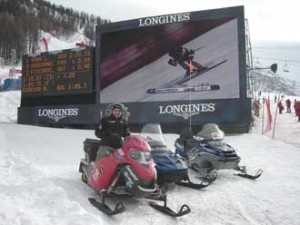
By Simon Ouellette
I’ve been in Val d’Isère, France at the FIS World Alpine Ski Championships for 12 days now and I’m starting to understand how the Maytag Repairman feels. I’m here as technical support for McGill’s electric snowmobile, which is being used to help cart off waste from the competition site. But in terms of technical work with the snowmobile, all I’ve had to do so far is show the volunteers how to turn the machine on.
The organizing committee for the two-week event had undertaken a huge challenge to receive more than 200,000 spectators at the site 1,850 metres above sea level in the French Alps. One of the main issues: how to minimize the environmental effects of such a massive event in a relatively remote location.
A major sponsor of the event supplied dozens of sorting stations where visitors could dispose of their waste. As a result, hundreds of garbage and recycling bags would need to be removed daily.
The question became how to remove these hundreds of bags spread over the snow-covered terrain for two weeks in France, where gasoline-powered snowmobiles have been outlawed unless the user obtains a special permit.
The solution? Electric snowmobiles.
Although they can’t replace the majority of gasoline snowmobiles, electric models can serve as a very good complement to their gas-powered cousins in a number of short-range applications.
Since snowmobiles have a very high power draw, the issues of available power and energy on board are critical. In order to have a commercially viable electric snowmobile, the key is to ensure it has the proper amount of power and energy available for a given task without over-designing it.
It was decided McGill would supply the event with an electric snowmobile. The vehicle in question had been used last winter as part of a Master’s thesis.
On top of hauling waste from the sorting stations to the main facility in Val d’Isère, the snowmobile also carries equipment to and from the site and transports podium finishers from the competition site on the Rhone-Alps slope to the press conference and doping testing areas.
On the first day of competition (the women’s Super G), the plan was to have the podium finishers and the doctor charged with the task of following them until they do the doping test, ride on a large half snowmobile-half monster truck vehicle. Then coaches would follow on snowmobiles.
But things didn’t go as planned. Before I knew it, I had the doctor, a coach and the Austrian bronze medalist on the electric snowmobile. The machine is a one-seater that can accommodate two if needed. We were four.
Suddenly, the big machine carrying the French silver medalist drove off. The doctor in charge of keeping visual contact with the athletes was on my sled and I had to follow or else there would be a doping procedure problem.
I had to drive standing up with my legs pressed against the steering. The result: I could barely steer. It wouldn’t have been so bad on wide-open terrain, but I had to keep contact with another vehicle toward which dozens and dozens of young French supporters were converging from every possible direction.
As I was trying to avoid all the people, not only did I have to do it with reduced manoeuvrability, but I also had to be very gentle with the break and the accelerator. The slightest jerk and the Austrian bronze medalist I was carrying would have flown off. I had visions of her on the ground with a broken leg.
The whole ride was only a few hundred metres long, but it seemed to last an eternity. Eventually we arrived. You can’t imagine how relieved I was when I turned and saw that all three passengers were still on the snowmobile; all in one piece, smiling. At that point I thought, “Well, looks like this electric snowmobile has passed the ultimate test in terms of smooth riding and handling!”
Simon Ouellette is a PhD student under the supervision of Prof. Peter Radziszewski in the Department ofMechanical Engineering. His broad research interest is in the world of energy efficiency. More specifically he has been involved in a number of projects relating to advanced transportation (both on and off road vehicles) and fuel cycle analysis. His Master’s thesis was entitled Investigating the Development of a Zero Emission Electric Utility Snowmobile.
